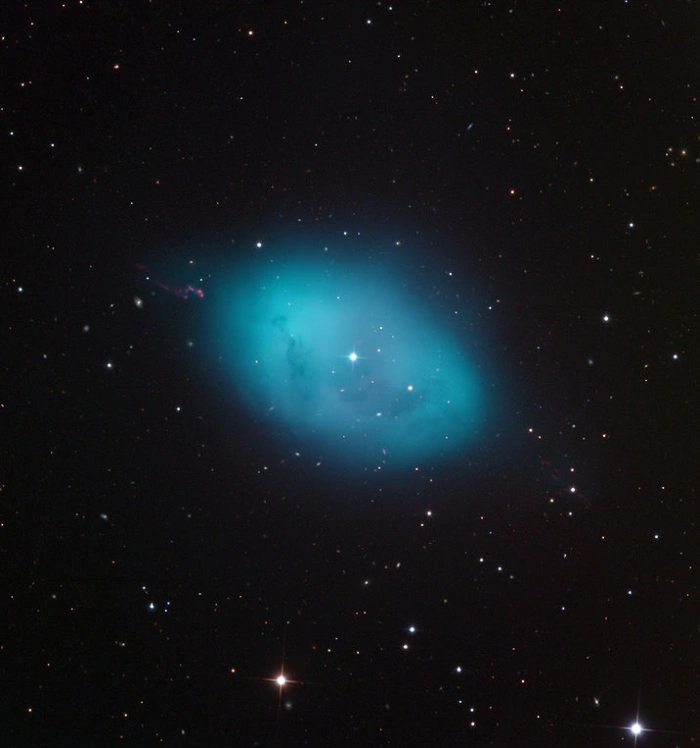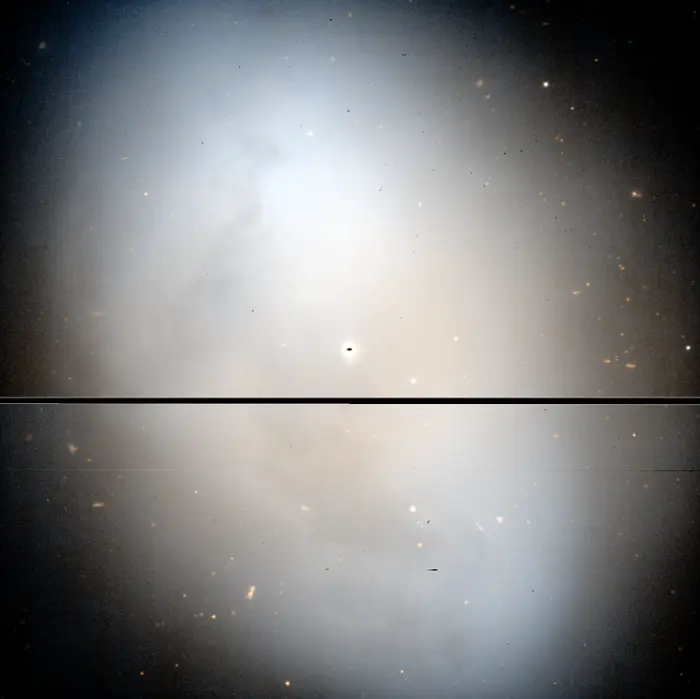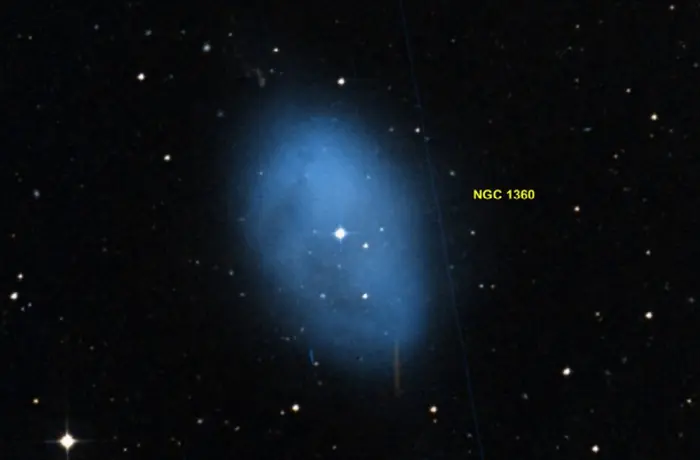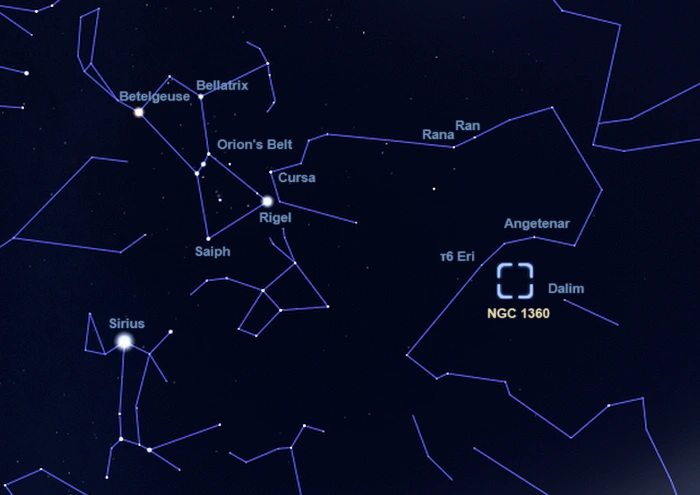The Robin’s Egg Nebula is a planetary nebula located 1,145 – 1,794 light-years away in the southern constellation Fornax (the Furnace). It has an apparent magnitude of 9.4 and an apparent size of 11 by 7.5 arcminutes. The nebula is listed as NGC 1360 in the New General Catalogue.
NGC 1360 is notable for its large apparent size. The nebula is around five times larger than the better-known Ring Nebula (Messier 57) in the northern constellation Lyra. Depending on its distance, the Robin’s Egg Nebula may have a physical size of 4.4 to 8.2 light-years. Planetary nebulae are typically about one light-year across.
The distance to NGC 1360 is uncertain. The value of 351 parsecs (1,145 ly) is derived from data obtained with the Hipparcos satellite. A 2014 study found a distance of 550 parsecs (1,794 light-years) and a 2018 study adopted a distance of 421 parsecs (1,373 light-years).

Robin’s Egg Nebula (NGC 1360), image credit: Adam Block/Mount Lemmon SkyCenter/University of ArizonaAdam Block/Mount Lemmon SkyCenter/University of Arizona (CC BY-SA 4.0)
Planetary nebulae form when evolved red giant stars reach the end of their lives and expel their outer gaseous envelopes into space. These layers of expelled gas are illuminated the hot exposed cores of the central stars and glow as bright planetary nebulae.
Planetary nebulae are a relatively brief stage in the evolution of low-to-intermediate-mass stars. They only last about 10,000 years. The clouds of ejected material eventually disappear into the surrounding space and the remnants of the central stars cool and fade as they slowly evolve into white dwarfs.
The central star of Robin’s Egg Nebula is catalogued as HIP 16566 in the Hipparcos Catalogue. It has an apparent magnitude of 11.34.
The central star is a binary system. Its binarity was suspected as early as 1977, but not confirmed until 2017. The star system is composed of a hot O-type star with a mass of 0.555 solar masses and a white dwarf with a mass of 0.579 solar masses. The two components have an orbital period of 142 days. Both components must have originally been more massive than the Sun. (Less massive stars would take longer than the current age of the universe to reach the end of their life cycles.)

Robin’s Egg Nebula, image based on observations made with the European Southern Observatory
telescopes obtained from the ESO/ST-ECF Science Archive Facility. Credit: ESO/ST-ECF Science Archive FacilityESO/ST-ECF Science Archive Facility (CC BY-SA 1.0)
NGC 1360 is the product of a common-envelope evolution. It has a kinematic age of about 10,000 years.
In the 2000s, low-ionisation structures were detected along the polar axis of the Robin’s Egg Nebula. These structures are younger than the nebula’s main shell and they expand faster.
In 2017, observations with the High Resolution Spectrograph (HRS) on the Southern African Large Telescope (SALT) revealed a ring configuration of 120 other low-ionisation structures in the nebula.
Facts
Robin’s Egg Nebula was discovered by the American astronomer Lewis Swift in 1859. German astronomer Wilhelm Tempel independently discovered it on October 9, 1861. Friedrich August Theodor Winnecke, another German astronomer, found the nebula in January 1868 and Latvian astronomer Eugen Block discovered it on October 18, 1879.
Winnecke is often credited for the discovery of NGC 1360 because he published his observations before Swift and Tempel. Swift published his discovery in 1885 and Tempel in 1882.

Robin’s Egg Nebula (NGC 1360), image: DSS (Digitized Sky Survey), Donald Pelletier (CC BY-SA 4.0)
Location
The nebula NGC 1360 lies in the faint constellation Fornax (the Furnace), which appears in the bend of the celestial River (Eridanus). The nebula lies in the same region as Angetenar (Tau2 Eridani) in Eridanus and Dalim (Alpha Fornacis) in Fornax. It can be found along the imaginary line connecting Dalim (mag. 3.85), the brightest star in Fornax, and the mag. 4.22 star Tau6 Eridani in Eridanus.
At declination -25° 52’, Robin’s Egg Nebula is visible from locations south of the latitude 63-64° N. In spite of its relatively large size, the nebula has a low surface brightness and is a challenging object for amateur telescopes.

The location of Robin’s Egg Nebula (NGC 1360), image: Stellarium
The best time of the year to observe NGC 1360 and other deep sky objects in the constellation Fornax is during the month of December, when the constellation rises higher above the horizon in the early evening.
Robin’s Egg Nebula – NGC 1360
| Constellation | Fornax |
| Object type | Planetary nebula |
| Right ascension | 03h 33m 14.6468527944s |
| Declination | −25° 52′ 17.977647900″ |
| Apparent magnitude | 9.4 |
| Apparent size | 11.0’ x 7.5’ |
| Distance | 1,145 light-years (351 parsecs); 1,794 ly (550 pc) |
| Names and designations | Robin’s Egg Nebula, NGC 1360, PN G220.3-53.9, PN ARO 208, PN M 1-3, PN VV 10, PN VV’ 16, PK 220-53.1, ESO 482-7, PKS J0333-2551, PKS 0331-260, AM 0331-260, GC 5315, CD-26 1339, CD-26 1340, CPD-26 389, EUVE J0333-25.8, 2EUVE J0333-25.8, GSC 06450-01071, GSC2 S0332120288, HIP 16566, IRAS 03311-2601, 2MASS J03331464-2552180, OHIO E -252, PHL 1556, PPM 246372, RX J0333.2-2552, SBC7 128, SBC9 177, WEB 3162, TD1 31132, TIC 144600802, TYC 6450-1071-1, Gaia DR2 5084896688945791232, Gaia DR3 5084896688945791232 |